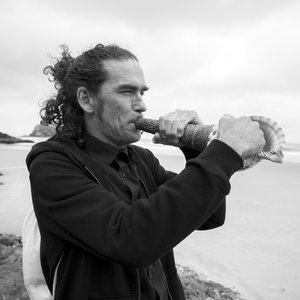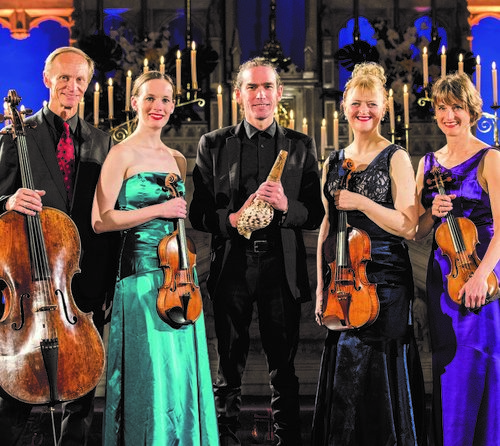Taonga Pūoro, Rob Thorne, and the NZSQ

The musical category of
taonga pūoro includes a variety of traditional
instruments that fulfilled many functions within Māori
society, including a call to arms, communications with the
gods, the dawning of a new day, and the planting of crops.
Their tones, tunes, and distinct timbres imitate natural
sounds, such as the wind and sea, as well as birds and
insects. The stone, wood, shell, and bone instruments come
from the earth and water, comprising a variety of flutes,
trumpets, percussion, and whirled instruments that produce a
quality of sound and resonance unique to Aotearoa.
Taonga pūoro are intimately connected with Māori culture and religious practice. Not only are they are significant in sacred rituals, but also fulfill a narrative role directly related to the gods and the creation story in which they sang the universe into existence. The universal building blocks of music, melody (Rangi) and rhythm (Papa), are named after the Sky Father and Earth Mother from the Māori creation mythos, while further classifications are derived from their children: the god of the winds is Tawhiri and from him come the wind instruments; shell instruments are the gifts of Tangaroa, god of the sea; Tane and his daughters Hine Pu te Hue and Hine Raukatauri govern those instruments derived from forest and earth materials.
The use of these instruments as part of the toolkit of the tohunga (Maori priests or healers) creates an oral flux between the temporal and the spiritual - between Ira Tangata (man) and Ira Atua (the Divine/Gods) - which is why Māori regard them with both awe and respect. Historically, they were regarded as taupe. When used for purposes of entertainment or recreation, it was a hidden and private practice, and many of these musical traditions became obscure due to spiritual reservations Māori held about the use of such instruments. However, pioneer ethnomusicologists such as Richard Nunns, Hirini Melbourne, and Brian Flintoff have provided a wealth of knowledge and detailed information about the history and stories surrounding these treasures.
Contemporary instrument makers sometimes use substitute materials and several instruments are a combination of materials that fall into more than one family. Nowadays, taonga pūoro are employed in many genres of music from classical, orchestral, chamber music, through to pop, alternative, and film music. They were used in the soundtracks of Once Were Warriors and Whale Rider and are becoming more widely used in television and film music to produce authentic natural sonorities, rather than artificially generated sounds. In 2010, British film and orchestral composer, Paul Lewis collaborated with master taonga pūoro composer and performer Horomona Horo to produce Legends of Rotorua, a fifty-minute composition for a wide variety of taonga pūoro, string quartet, harp, flute, storyteller, and soprano. Horo has collaborated with numerous artists such as Moana and the Moahunters, the New Zealand String Quartet, Canto Maori, and Irish group Green Fire Islands. Contemporary New Zealand composers such as Gillian Whitehead and Martin Lodge have combined taonga pūoro extensively with western instruments. Taonga pūoro have also been incorporated into hip-hop, reggae, and funk-based beats by such bands as Salmonella Dub, Tiki Taane, and Fat Freddy's Drop.
With more than twenty-five years of performance experience, predominantly within alternative rock, free noise, and experimental and improvisational sound installations, Rob Thorne (Ngāti Tumutumu) has been working with these traditional Maori instruments since 2001. He grew up in a Hamilton household that prized singing and music, picked up the trumpet at ten, then moved onto guitar. While a student at Massey University, he busked around town and playing both solo and in groups as part of the local free noise, alternative rock, and experimental music scenes of the time. Thorne spent over two decades in the alt-Palmy experimental and industrial noise scene. He has since continued to explore that free ethic, playing guitar and singing in numerous noise and hard rock bands, alongside a developing an academic path that includes the construction of his own traditional instruments. His Post Graduate Diploma research became a museum exhibition (Koauau: The Music Within). “My plan was to write my masters on the principals and community of the Palmerston North noise scene,” he told NZ Musician's Martyn Pepperell. “A good friend of mine who was doing post-grad at the same time, sat me down and said, ‘Look man, why are you doing your thesis on this when you’re in the gardens all the time playing your koauau? Why don’t you do your master’s thesis on that?’”
“I became entangled in various webs of mystery in regards to what I believed had been traditionally done,” he recalls. “Ten years of research and playing passed.” Introduced to loop pedals in the late 2000s, he started using them in conjunction with his hand/home-made wood, stone, bone and shell instruments, integrating the skills he had learned from the free noise scene into his practice. He says the approach remains very minimalist, for now, his Boss RC300 used in a very simplistic way for this album - “I began operating sound as music, rather than operating from the traditional Western composition space.”
Thorne used a Te Waka Toi Quick Response Grant from Creative NZ to record three pieces: a free noise work with Campbell Kneale; some avant beats with engineer/producer Ben Horton as Uenuku; and a single epic composition titled Whāia Te Māramatanga with Steve Garden, sound engineer and head of the art music label Rattle. Whāia Te Māramatanga is an immersive 78-minute listen, best suited to headphones and darkness, one where the ancient music traditions of Aotearoa collide with a free noise-informed search for a future. “Conceptually speaking, the album is about a journey of learning … It’s a journey from not knowing yourself to knowing yourself. It’s a journey from not knowing much to knowing more. It’s a classic dark-to-light story, a journey from below to above. My journey as a musician has been about survival and living, to the point where now life is good. I want to live and I’m a better person because of being a musician.” Written and arranged with a collection of taonga pūoro and modern loop pedal technology, Whāia Te Māramatanga is Thorne's personal contribution to the continuation and development of this ancient musical tradition. “There is a stream of tradition in there which is obvious with the use of taonga pūoro, yet overall the work is a modern work,” he says. “It is a work I have put together this century, this decade. It’s about me using taonga pūoro musically, not traditionally. It’s about experimentalism, acoustics, and the way that sound works.”
Thorne also started practising Reiki as a spiritual practice to "help myself out of what was a spiritual and emotional jam at the time … The Reiki and the instruments, when they came together I found I was able to finally express myself in a way that didn’t compromise who I was. I became more assured of who I was as well. Knowing that you are Māori, being raised to know this, is not the same as ‘being’ Māori - being able to practise, daily. The instruments, the music are my te reo. Playing the instruments has given me a direct channel into that, and now I see this as a two-way street, where it has given my ancestors a way to access me, to fulfill my ancestral role or destiny. There is definitely a ‘bigger than both of us’ thing going on here for me, and I’ve given up ‘fighting it’.”
Thorne has traveled the country researching museum collections, teaching, demonstrating, collaborating and performing, as well as working academically and musically with pioneers like Nunns. Over the past five years he has completed an MA in Social Anthropology and incorporated this diverse experience to create long, beautifully transcendent, ambient compositions using sound loops, intelligently blending ancient and modern techniques. He has participated in a cultural exchange and performance series with Korean dancer & drummer Saes Byeol Cha and Italian guitarist Lorenzo Buhne, was nominated Manawatu Student City Musical Artist of the Year, and opened Palmerston North's Christmas in the Park.
In 2013 he collaborated with director Vanessa Stacey on her acclaimed Summer Shakespeare production of The Tempest; performed with Nunns at the Voices of Sacred Earth conference; recorded for Dudley Benson's Forest remix project; composed and performed for UCOL Performing Arts Diploma. student productions; and was invited to participate in Phil Dadson's Sounding Tiritirimatangi, alongside Don McGlashan and many others. He also executed a crowd-funding campaign to travel to the Peruvian Amazon to research and experience ancient indigenous sound-healing techniques. While visiting Lima, he performed solo, collaborated with jazz drummer Steve Cournane, and lectured on his work with taonga pūoro. 2014 brought the worldwide release of the album and a national tour, including a return to Tiritirimatangi, collaborating with Dadson again, as well as Chilean musician Enrique Sique, drummer Chris O’Connor (Phoenix Foundation) and Michael Morley (Gate, The Dead C).

Te
Ao Hou/This New World
Now married, bespectacled, and somewhat less hirsute, Rob Thorne combined with the New Zealand String Quartet to perform compositions by Gillian Whitehead, Gareth Farr, and Salina Fisher, as well as the world premiere of Tomokanga, as part of the NZ Festival. In the celestial setting of Wellington's St Mary of the Angels, the captivating synergy between taonga pūoro and Western string instruments suggested an oneiric, ephemeral, and hallucinatory landscape of shifting light and shadow. This was music that segued seamlessly between the various composers, imbued with the same sort of shimmering luminosity and glistening iridescence as a rain forest after thunderstorm. The interweaving of disparate sonorities created limpid, mesmerizing, and hypnotic motifs that lingered on the margins of the transcendental.
"The concept of Tomokanga is … about working towards a gateway and then breaking through that gateway," said Thorne, describing the spiritual journey on which he takes his audiences. "There's quite a geographical concept to the instruments. They are taken to a place somewhere in ancient Aotearoa. It isn't just be about watching pieces of music being played one after the other. We've constructed … pieces of music that will take the listener into a world for them." Thorne and his fellow musicians expertly guided their audience across a terrain of shamanic thresholds to a new awareness of the ways in which topographical formations can be connected to specific mythological stories and imagery.



 Te Whatu Ora Health NZ: Health Warning – Unsafe Recreational Water Quality At South Bay And Peketā Beaches And Kahutara River Upstream Of SH1
Te Whatu Ora Health NZ: Health Warning – Unsafe Recreational Water Quality At South Bay And Peketā Beaches And Kahutara River Upstream Of SH1 Wikimedia Aotearoa NZ: Wikipedian At Large Sets Sights On Banks Peninsula
Wikimedia Aotearoa NZ: Wikipedian At Large Sets Sights On Banks Peninsula Water Safety New Zealand: Don’t Drink And Dive
Water Safety New Zealand: Don’t Drink And Dive NZ Olympic Committee: Lydia Ko Awarded Lonsdale Cup For 2024
NZ Olympic Committee: Lydia Ko Awarded Lonsdale Cup For 2024 BNZ Breakers: BNZ Breakers Beaten By Tasmania Jackjumpers On Christmas Night
BNZ Breakers: BNZ Breakers Beaten By Tasmania Jackjumpers On Christmas Night Te Whatu Ora Health NZ: Health Warning – Unsafe Recreational Water Quality At Roto Kohatu Reserve At Lake Rua
Te Whatu Ora Health NZ: Health Warning – Unsafe Recreational Water Quality At Roto Kohatu Reserve At Lake Rua